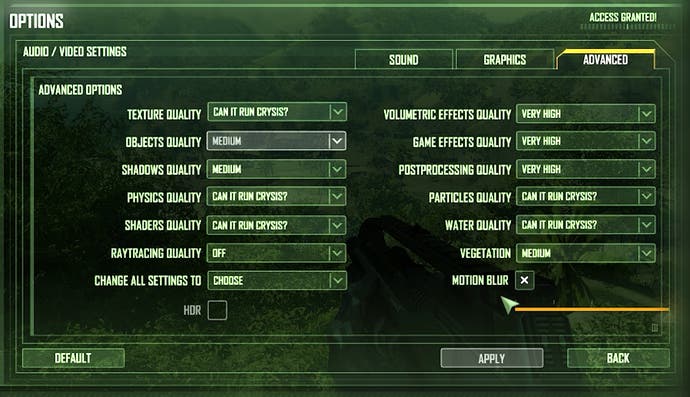Crysis Remastered PC tech review: brutal performance limits can't be overlooked
Beautiful lighting and ray tracing, but a locked 60fps is completely off the table.
Digital Foundry's love of Crysis is well documented and the announcement of its remastering remains one of our highlights of the year. Delays to the launch were a sign that not everything was running to plan, but our hopes remained high, especially when Saber Interactive delivered an excellent Nintendo Switch port of the game. However, the PC and consoles versions have now arrived and even our faith in the franchise is being tested. Crysis Remastered has potential and some stand-out technology, but the fact is that key technical decisions have been made that brutally undermine the quality of the final product. Especially on PC, the game is a disappointment.
We'll be talking about the console versions in a separate article - principally because we're informed that a performance patch for Xbox One and Xbox One X will address key issues we have with the game, as mentioned on launch day. Having seen pre-release Xbox One X code operating at a better level of performance than the final release, we retain some level of optimism here. With PC, we find ourselves highly conflicted about the game. On the one hand, Crysis Remastered pushes technology forward in some remarkable ways, but on the other, it's clear that the whole enterprise is based on the legacy CryEngine 3 versions released way back in 2011 for Xbox 360 and PlayStation 3. With that comes compromises to the art that are objectionable, but more crucially, there's a reliance on single-thread performance that means that it's almost impossible to run this port at a locked 60 frames per second - even on a Core i9 10900K, the fastest gaming CPU on the market today.
We'll start with the positives though. Sparse voxel octree global illumination - SVOGI - from the latest CryEngine has been incorporated into the PC build. This technology essentially performs a specific type of software ray tracing to simulate how diffuse light is bounced around an environment, significantly upgrading the lighting of any given scene. All together, SVOGI has a huge effect on the game's visual quality, which can be easily seen by turning it off and on in the options. The difference between real-time GI and a system based on screen-space ambient occlusion and ambient colour probe lighting is profound, and it's one of the standout improvements in the game.
SVOGI's approach to bounced diffuse lighting is impressive, but Crysis Remastered also adds ray traced reflections to the mix. Both software and hardware accelerated versions are available, meaning you don't even need a DXR-capable card to see the effect. What's remarkable about this is that while Crytek's software version is API agnostic, somehow the team has managed to get hardware RT working on a DX11 game, something we've not seen before. This is achieved by interfacing with the Vulkan API for ray tracing functions - on an RTX 3080, this speeds up the process by 40 per cent. It's a fascinating way to access the latest hardware advances without rewriting the engine for native Vulkan or DX12, with all of the complex memory management that involves. The only problem is that bafflingly, using RT reflections can see frame-time stutter of up to 500ms - half a second. Therefore, it's difficult to recommend using them until Crytek patched out this behavior.
The next largest technical advancement on the PC build is the inclusion of up to 8K textures on many of the game's models - the most obvious of which is found on the Nanosuit itself, where you can see each element of its alien metal weave and musculature in quite exquisite detail. Other environmental textures get the same treatment, like the dry sand on the ground, complete with parallax occlusion mapping - where each and every shadow casting light affects their screen-space shadows in the parallax map (a technical detail that the first Crysis had, but not many games have had since). Screen-space shadows also make the grade, better connecting smaller elements like foliage and twigs to the ground - a huge improvement over Crysis 2007.
The last more visible technical upgrade is found in the game's depth of field and post-processing - the basic gaussian depth of field from the original is replaced with CryEngine's bokeh depth of field, which makes bringing up the weapon modification menu look extra nice. On top of that, with the game's more modern bloom and flare system, some of the more alien levels look significantly improved beyond anything we've seen from the game before. Draw distance is also massively improved - Crysis 2007's very high preset is basically equivalent to Crysis Remastered's medium. To a lesser degree, the same applies to vegetation and shadow distance.
On the very high preset and beyond, Crysis Remastered has much higher distance rendering for all game objects. On the "Can it Run Crysis Mode?" - which is the highest setting in the remaster - all objects have their highest geometry count no matter the distance and shadow maps, vegetation, and everything are pushed far out, along with screen-space shadows running at their maxed distance, while shadow map resolution doubles. It is absurdly more detailed than the original game - to a point of excess.
The art side of the game has changed significantly and to my taste, not to the better in many regards. Some aspects look straight-up better - like the SVOGI lighting, for example, along with the ray traced reflections and much improved physical materials. However, I do recommend checking out the video at the top of this page, where I go into more depth on legacy art changes from the PlayStation 3/Xbox 360 ports that remain in this new version, looking visibly worse to my eyes than the original. These are changes that shouldn't have been retained in the remaster. I simply don't have the space here to detail them all of these legacy downgrades in depth, but the sheer amount of them suggests that basing the remaster from the 2011 console ports was fundamentally a bad idea - Crytek and Saber Interactive have had to re-inject a lot of the original game's features back into the port, but there's still a lot of the original art and effects missing. For a game that began life as a PC exclusive like nothing seen before, the idea that Crysis Remastered incurs technical debt from the last-gen consoles is deeply disappointing.
The Xbox 360/PS3 foundation affects other areas of the game, like the occasional low frame-rate animations you see in the vegetation, or how grenades and explosions no longer cause vegetation to move and sway. It's also seen in how the fences and physics objects break in more simplified ways and into bigger chunks than Crysis 2007, or how there are missing shadows from certain lights, or missing shadows from certain objects, or just reduced quality shading in many areas. Alternatively, consider the way that clouds are rendered: the original Crysis used ray marched volumetric clouds at times, but these are missing in the remaster, replaced by inferior alpha transparencies. It's just not good enough that a remaster of a classic PC game should have so many aspects of the art that are actually inferior to the original game. I was thinking that possibly the Crysis modding community could help, but right now there is no game editor for Crysis Remastered - though Crytek says that may be addressed sometime in the future. What won't be addressed is the omission of the Ascension level. According to the developers at Crytek, they just do not like the level at all and its omission is down to that, and not to its super-heavy hit to performance. Ascension may be short and a bit of a gimmick, but I miss how amazing it looks and how great its cutscene is.

The final section of this review tackles the biggest disappointment of all: performance. The original Crysis still ruins modern CPUs owing to its heavy reliance on single-thread performance. It basically uses just two cores in total, with one core taking over the responsibility for almost everything. The basic reality is that achieving 60fps is an impossibility in the game owing to the way it tackles processing of object draw distance. And even if your CPU is good enough for that - like Intel's Core i9 10900K - AI activation in the game is also extremely heavy, overloading that one utilised core. Remarkably, when you activate a bunch of AI in the town level, the Core i9 10900K running Crysis 2007 at very high settings can still drop to the low 40s and upper 30s, even on a normal gameplay level. Let's be clear: even today, you cannot play Crysis 1 at 60fps on any PC. This is why a remaster was crucial, so that we could finally play the game at a consistent 60fps or higher with no CPU bottlenecks and no stutter.
Astonishingly, despite some improvement, Crysis Remastered is still CPU-limited in object drawing, and it's still heavily reliant on single thread performance generally, to devastating effect. There is indeed more threading than Crysis 2007, and AI activation no longer tanks frame-rate like it does in the original, but we are still looking at a game that is not optimal for today's many-core processor architectures. Even at high settings - which pushes out shadows, vegetation and objects beyond the original - we soon hit a CPU bottleneck. In fact, some scenes running at high settings operate at half the frame-rate of the game running at medium. I've put together the closest I can get to optimised settings and unfortunately, even the fastest gaming CPU on the market - the Core i9 10900K - still cannot lock to 60 frames per second. To put this into perspective, Crysis 3 from 2013 can utilise all 20 threads of the 10900K, but Crysis Remastered cannot.
With that in mind, choosing the best settings is a weird exercise. Measuring the impact on GPU performance for individual features barely matters if you hit CPU limits anyway, and I could prove this by using a welcome feature of Crysis Remastered - the ability to make your own benchmarks. Using this feature, I ran a time demo from the town in mission two and discovered some cold hard facts about CPU requirements for Crysis Remastered. For one, the Core i9 10900K cannot process very high draw distance settings for vegetation, shadows, and objects: it will be below 60fps at points and longer frame time stutters kick in. This is without ray tracing too, which hits CPU performance by a further 10 per cent. With all of this in mind, it's reasonable to assume that if a 10900K cannot do it, no CPU can. Tests with a Ryzen 9 3900X showed that single thread power is king - Crysis Remastered doesn't run well on AMD hardware. If the Intel processor is in trouble, Ryzen has even more issues.
Further testing revealed that adjusting resolution in Crysis Remastered actually affects CPU frame-rate. That sounds completely counter-intuitive as resolution scaling is something the GPU deals with in painting the pixels, but I think Crysis Remastered is may be selecting LODs based on the density of pixels, so a higher resolution is more expensive on the CPU as well. This is something that was definitely the case for Crysis 2007. The bottom line is that I measured an average 13 per cent performance loss when increasing resolution from 720p to 1080p on the Core i9 10900K, with a peak of a 20 per cent fps drop in the heaviest individual scene.
With that in mind, optimised settings are not possible on this game owing to its profound CPU limitations and the way that the bottleneck increases according to resolution. My advice would be to take a look at the options set-up screenshot on this page, which aims to strike a balance between improving on the visual density of Crysis 2007 while at the same time pulling back Crysis Remastered from its extremes, ensuring that a modern gaming CPU at least stands a chance of giving a decent experience. But a locked 60 frames per second throughout? No chance.
In summary, I'm highly conflicted about Crysis Remastered. I find some of the technological additions and asset work to be brilliant - SVOGI and RT reflections in particular look wonderful - but the legacy art issues and brutal CPU limitations are extremely problematic. Just the basic idea that it's essentially impossible to run a remaster of a 2007 game at 60fps on the fastest gaming CPU available, even with key settings at medium, basically means that there's a fundamental issue here that needs addressing - and that the game should not have released in this state.




















